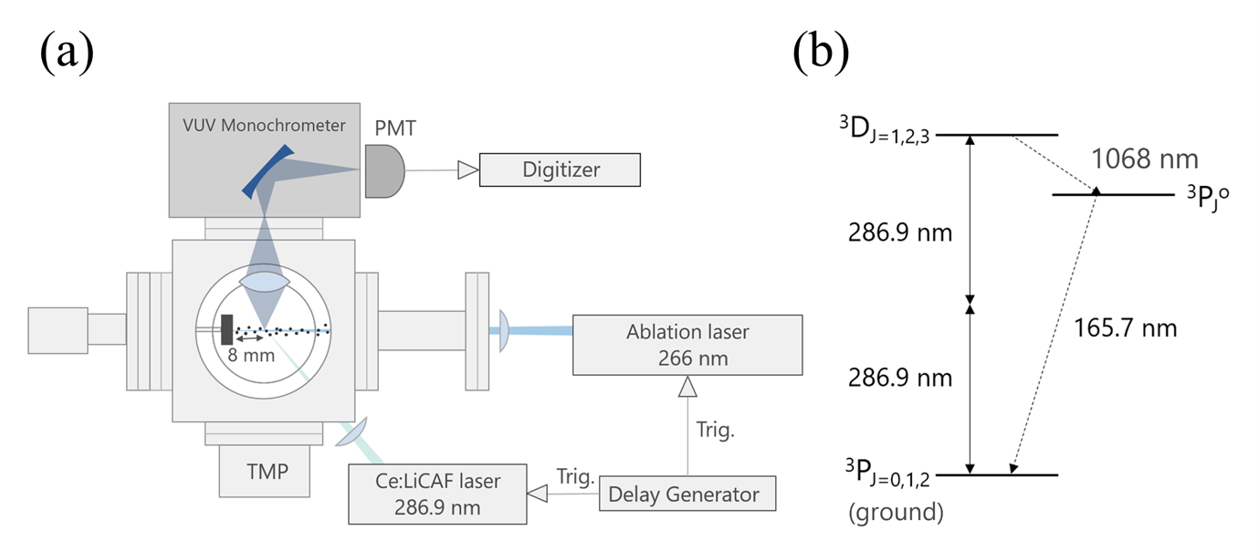Description
Ultracold atoms, made possible by laser cooling and trapping, are used as platforms for a wide range of applications such as observation of quantum degeneracy [1], quantum simulation [2], frequency standards [3] and ultracold collision studies [4]. While experiments using ultracold atoms of alkali metals and alkaline earth metals have made great progress, laser cooling has not been realized for atomic species of chemical and biological interest including carbon and hydrogen. The reason is that the optically allowed electronic transitions from the ground state of these atoms lie in the vacuum ultraviolet (VUV) region, making it difficult to construct light sources to drive effective cooling. In the case of carbon, laser cooling on two-photon transitions with a mode-locked laser has been discussed [5]. However, a gas production method in vacuum for neutral carbon with low vapor pressure has not been established. Furthermore, to the best of our knowledge, two-photon excitation of carbon atoms in vacuum has not also been demonstrated.
Here we demonstrate gas production of carbon atoms in the ground state using laser ablation of a graphite in vacuum and observation of produced atoms through two-photon induced fluorescence. This method is expected to be a fundamental technique applicable to laser cooling of carbon.
Figure 1 shows the experimental setup and the schematic energy level diagram of carbon showing the involved levels and transitions. Carbon atoms were produced by focusing the 266 nm radiation from the fourth harmonic of a Q-switched Nd:YAG laser on a rotating highly oriented pyrolytic graphite (HOPG) target. Produced particles including ions and molecules as well as atoms were expanded in a vacuum chamber.

Nanosecond pulses from a homebuilt, tunable Ce:LiCAF laser pumped by the fourth harmonic of another Q-switched Nd:YAG laser were used for the two-photon excitation. The laser wavelength was tuned to the two-photon resonances of the $^{3}$P-$^{3}$D transition at 286.9 nm. The laser beam was focused into a spatial region at a distance of 8 mm from the target. The delay time between atomic gas production and two-photon excitation was adjusted with a digital delay generator. The two-photon induced fluorescence at 165.7 nm was detected perpendicular to both the excitation laser beam and the atomic beam. A 0.2 m monochromator equipped with a solar-blind photomultiplier tube (PMT) was used for the detection.
We will introduce the density and the temperature of produced atoms evaluated through the observation of the two-photon induced fluorescence. It was confirmed that when the laser fluence was excessively high, carbon atoms were produced in the high-energy excited states with long lifetimes unsuitable for laser cooling. The dependence of the behavior of the produced particles on the laser fluence will be discussed in conjunction with the results of plume emission spectra and time-resolved emission measurements. In addition, the precooling method for actual laser cooling of the atoms produced by our method and the design of our cooling laser at a wavelength of 286.9 nm will also be presented.
This work is supported by JST Precursory Research for Embryonic Science and Technology Grant Number JPMJPR190B and MEXT Quantum Leap Flagship Program Grant Number JPMXS0118067246.
[1] M. H. Anderson et al. Science 269, 198 (1995).
[2] M. Greiner et al. Nature 415, 39 (2002).
[3] H. Katori et al. Phys. Rev. Lett. 91, 173005 (2003).
[4] S. Inouye et al. Nature 392, 151 (1998).
[5] D. Kielpinski. Phys. Rev. A 73, 063407 (2006).
| Presenter name | Takashi Sakamoto |
|---|---|
| How will you attend ICAP-27? | I am planning on in-person attendance |

